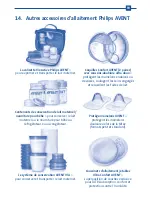
EN
5) Warmth and relaxation can encourage milk flow. Try expressing after a bath
or shower.
6) Try expressing from one breast while your baby is feeding from the other,
or continue expressing just after nursing.
7) Repositioning the pump on the breast from time to time can help stimulate
your milk ducts.
Practice with your pump to find the best technique for you. However, if the
process becomes very painful, stop and consult your breastfeeding advisor.
9. How to use the Manual Breast Pump
1) Wash your hands thoroughly and make sure your breasts are clean. Gently
squeeze a little milk from each nipple to ensure milk ducts are not blocked.
2) Make sure you have sterilized and carefully assembled your pump exactly
as shown in sections 3 and 6.
3) Consult the ‘Hints to help you succeed’ section.
4) Relax in a comfortable chair, leaning slightly forward (use cushions to support
your back). Make sure you have a glass of water nearby.
5) Press the funnel and Let-down Massage Cushion of the pump firmly against
your breast, making sure that no air can escape – otherwise there will be
no suction.
6) As you gently push down on the pump handle you will feel the suction on
your breast. You don’t need to depress the handle fully to create a vacuum;
only as much as is comfortable. Your milk will soon start flowing even though
you may not use all the suction the pump can generate.
7) Begin by pumping 5-6 times rapidly to initiate let-down. Then, hold the
handle down for 2-3 seconds, and allow it to return to its resting place.
These 2-3 second cycles imitate your baby’s natural suckling pattern and
allow the milk to flow into the bottle between strokes.
8) Milk should begin to flow after the first few strokes. Don’t worry if your milk
does not flow immediately. Relax and continue pumping.
EN
7. When to express milk
1) If possible, wait until your milk supply and breastfeeding schedule are well
established, normally at least 2-4 weeks after birth, unless told otherwise
by your health care professional or breastfeeding advisor.
2) The exceptions to the above are:
a) If you are expressing milk for your baby to be given in hospital.
b) If your breasts are engorged (painful or swollen), you can express
a small amount of milk before or between feeds to ease the pain
and to help your baby latch on more easily.
c) If you have sore or cracked nipples, you may wish to express your milk
until they are healed.
d) If you are separated from your baby and wish to continue to breastfeed
when you are reunited, you should express your milk regularly to
stimulate your milk supply.
3) You will need to find the right times of the day for you to express your milk, e.g.
a) Early in the morning when your breasts are full, just before or after
your baby’s first feed.
b) After nursing, if your baby has not emptied both breasts.
c) Between feeds, or on a break if you have returned to work.
8. Hints to help you succeed
Using a breast pump takes practice – you may need to make several attempts
before you succeed, but because the breastpump is so simple and natural to
use, you will soon get used to expressing your milk.
1)
Familiarize yourself with the pump and pieces prior to use.
2) Choose a time when you’re not rushed and won’t be interrupted.
3) Having your baby or a photograph of your baby nearby can help encourage
‘let-down’.
4) Placing a warm cloth on the breasts for a few minutes before you start
pumping can encourage milk flow and soothe painful breasts.
4
5























